Pilot Project Development Activities
Previous articles in this series have analysed some key aspects of European-level legislation with respect to the management and use of data (personal and non-personal, linked to the contexts of connected and smart mobility) and of European legislation with respects to digital platforms. The analysis highlighted several elements that must be considered in order to develop a new mobility paradigm based on connected vehicles in which data and their exchange are a key element for innovation.
This article is dedicated to the description of the activities carried out to identify smart mobility technologies and solutions capable of fostering field projects that can provide answers to 14 use cases and that can be associated with as many pilot projects identified during the 2021 Initiative as possible.
Indeed, the 2022 project activity of OCTO and The European House – Ambrosetti is based on specific objectives, notably:
- Gathering the attention and interest of multiple stakeholders around connected mobility issues and opportunities;
- Involve as many stakeholders as possible in the design and implementation of various pilot projects that practically demonstrate the application potential of connected mobility and the benefits that can be achieved.
The project path was defined with the aim of launching and substantiating the vision and mission of the Italian Way to Connected Mobility, identified by OCTO and The European House – Ambrosetti and communicated during the OCTO Connected Forum 2021.

To this end, seven Working Tables – Urban Planning, Road Safety, MaaS Models, Behavioral-based Pricing, Fleet Efficiency Monitoring, Transition to Green, Mobility Data Space – were held with the aim of providing a situational picture of Italian mobility and to engage different stakeholders. The Working Tables were an opportunity to present and discuss the 14 identified use cases and to identify possible implementation paths together with the stakeholders involved.
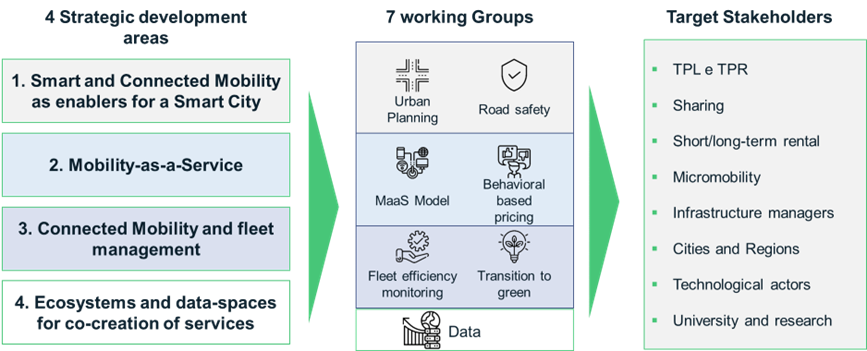
Following the Working Tables, various stakeholders were engaged in additional meetings, given their interest in exploring the opportunity to develop innovative pilot projects together with OCTO and The European House – Ambrosetti.
The engagement activities enabled OCTO and The European House – Ambrosetti to get in touch with 40 mobility stakeholders.
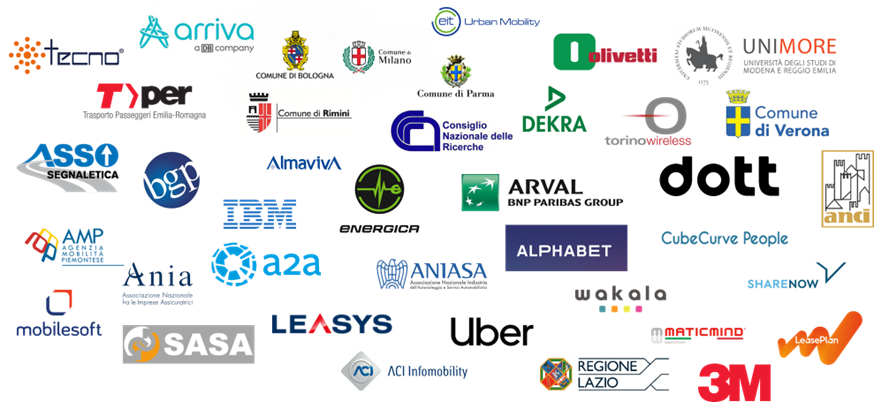
Pilot projects are in fact a concrete opportunity forstakeholders to test technologies and new operational approaches,while at the same time to obtain and develop skills and know-how.
The 14 pilot projects and the related use cases proposed by OCTO and The European House – Ambrosetti were shared by the stakeholders involved in the Working Tables and subsequently engaged as “examples of what can be done” and from which to address concrete development needs. In this sense, the opportunity to compare and discuss the points of view of various stakeholders, OCTO and The European House – Ambrosetti made it possible to identify new areas of collaboration, tailor-made with respect to the needs of the various stakeholders involved, but with solutions in line with the proposals defined in the pilot projects model.
Engagement with Public Administrations
The public stakeholder engagement approach was devoted to create awareness among public decision-makers about the technical structures of the opportunities for the development of a new connected and smart mobility ecosystem and the related benefits for public administration, urban mobility stakeholders and citizens.
In fact, bringing awareness to public administrations about the development of pilot projects proves to have a significant effect in creating links between the public world and enterprises. Private actors can become aware of the real needs of different public administrations, while the technical and political structures of the latter benefit from innovative technologies and approaches provided by private actors.
Including these two components in the framework of operational meetings made it possible to set off the process of designing new solutions that, through the use-cases of the 14 pilots, would address the priority needs of various public administrations.
Notably, the main needs of the municipalities emerged during the various meetings, are:
- Mobility infrastructure planning – the development of a connected mobility system requires a change of infrastructure;
- Management of city centre areas – Limited Traffic Zones (LTZs) can benefit from data connectivity to efficiently manage and monitor access;
- Establishment and management of Low Emission Zones – data is required to identify the best Low Emission Zones (LEZ) for each specific area, based on the different data mobility collected;
- Identification of frequent accident areas – data can support the detection of frequent accident areas, allowing action to be taken accordingly;
- Prioritisation of investments – data collection on the state of roads for prioritisation and improvement of maintenance work;
- Creation of rewarding mechanisms for virtuous citizens – by monitoring citizens’ driving styles (e.g. limited speed, correct parking behaviour, limited use of private vehicles, etc.), correct behaviour can be incentivised and encouraged.
Once the vision had been defined and the projects of interest were identified, the dialogue with the municipalities focused on defining the administrative setting to manage relations and the assets exchange (technology, data, know-how, etc.) between the various actors involved. From a formal point of view, the “procurement code” does not define how to carry out the development of innovative projects whereby resources are shared reciprocally and, through collaboration, are implemented. This aspect may represent a major limitation with respect to the possibility of making cities a virtuous context for the development of innovative projects.
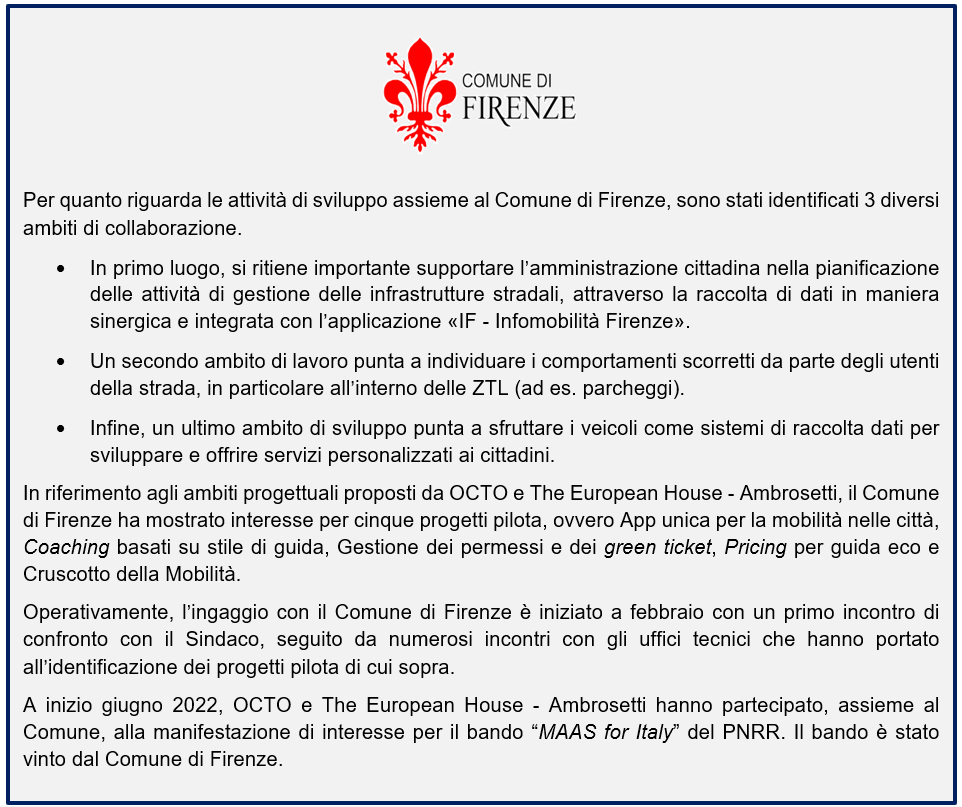
Engagement with private actors
Regarding the involvement of private stakeholders, i.e., companies, the main focus was on the co-creation of new services that would involve pooling technologies and databases from different actors, and that could give rise to new smart mobility products.
In fact, a first major area of development was the definition of new approaches to measure the sustainability performance of fleets, integrating different KPIs along the various dimensions of environmental, social and governance sustainability. This issue appears to be particularly relevant in light of the growing focus on sustainability, also from a regulatory and financial point of view.
The definition of these solutions depends on the ability to integrate different technologies capable of assessing the environmental performance of vehicles and fleets and capable of improving social performance. Social performance includes:
- Driver safety;
- The safety of people on board;
- The safety of people outside the vehicles;
- The quality of the public transport service.
The possibility of co-creation in this area lies in the ability to integrate different databases, to build APIs capable of acquiring homogeneous data from different types of media, and the possibility of installing on-board technologies

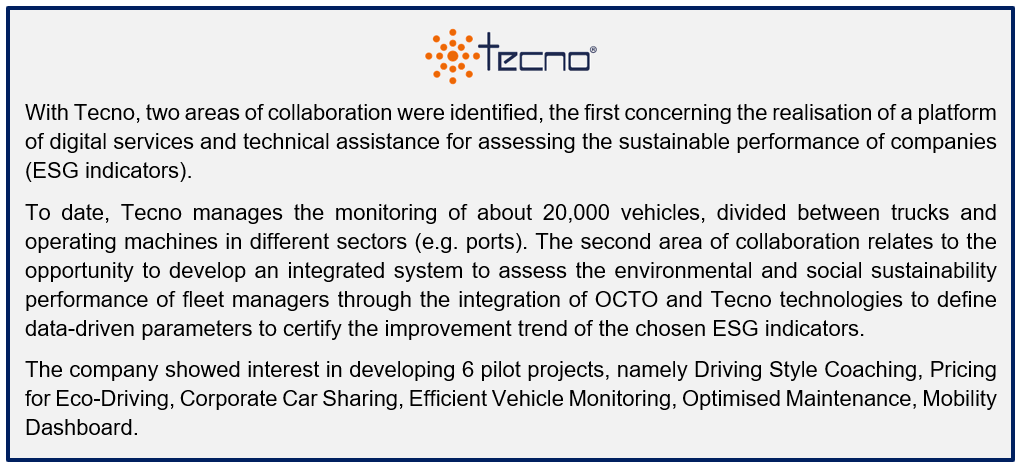
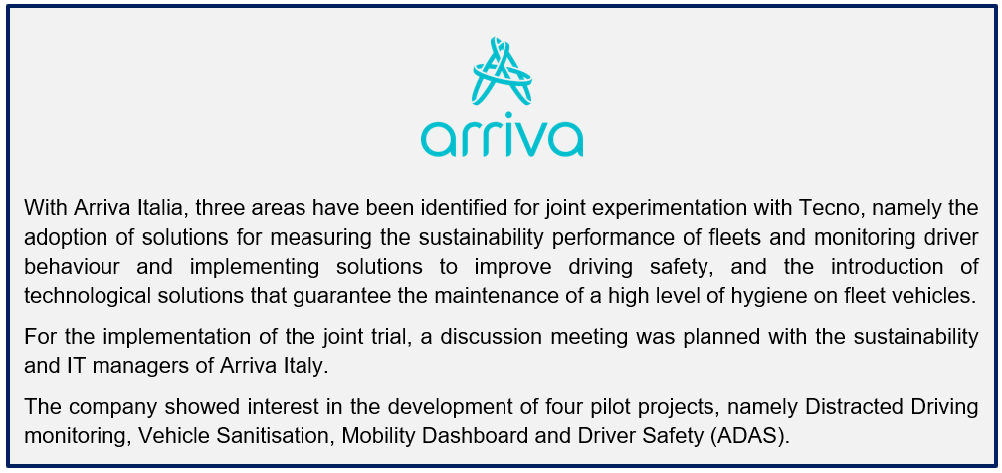
The results of the development activities of the different use-cases will be disseminated to increase the knowledge of the benefits linked to the adoption of technologies supporting the development of connected mobility systems.
In addition, the pilot projects will provide insights as to how co-operation between different actors is a key element in creating value within the new Data Economy ecosystems, also in mobility projects.
In fact, the pilot projects demonstrate how the pooling of technologies and databases from different sources and actors can enable innovative solutions for different mobility challenges, so that it can come closer to OCTO’s Vision Zero paradigm.
The 2022 edition of OCTO Connected Forum will be an opportunity to verify the progress of the development of pilot projects, and analyse the first (partial) results achieved and the challenges that still need to be addressed to remove process and regulatory obstacles, that can promote faster testing times especially in the most peripheral areas – that can therefore benefit from the qualified involvement and support for the launch of digital Smart Mobility processes.
The next article in this series will be dedicated to the launch of the OCTO Connected Forum by OCTO and The European House – Ambrosetti.
Author:
The European House – Ambrosetti